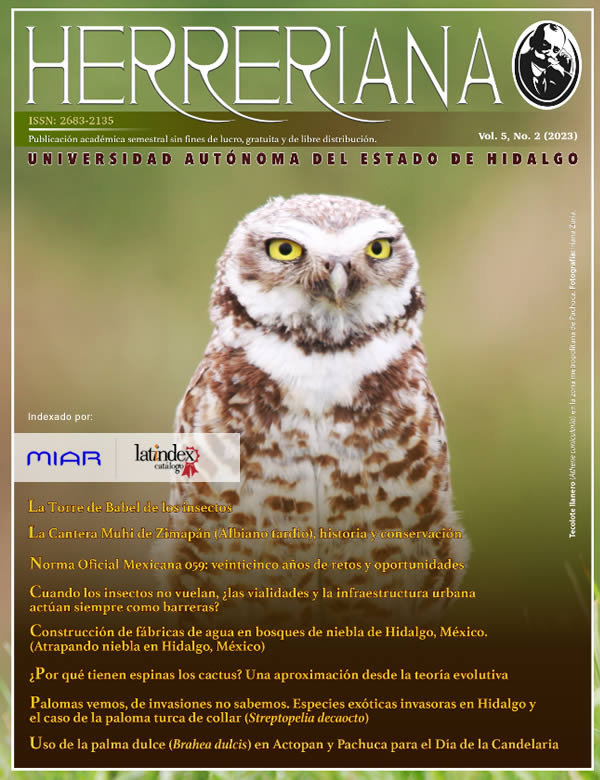La Torre de Babel de los insectos
DOI:
https://doi.org/10.29057/h.v5i2.10261Palabras clave:
comunicación, uso de señales, insectos sociales, insectos solitarios, insectos gregariosResumen
La comunicación es vital para el funcionamiento de las sociedades animales, y en el caso de los insectos la manera en que éstos se comunican está estrechamente ligado a su forma de vida. Para entender cómo es que los insectos pueden transmitir mensajes entre ellos, los científicos han estudiado las señales químicas, acústicas o vibratorias, visuales y táctiles que ellos utilizan para regular sus actividades, alimentarse, reproducirse e inclusive explotar los recursos de otros insectos. Los sistemas de comunicación de animales se encuentran en constante evolución, por lo que año con año se descubre más sobre este fascinante tema.
Descargas
Información de Publicación
Perfiles de revisores N/D
Declaraciones del autor
Indexado en
- Sociedad académica
- N/D
- Editora:
- Universidad Autónoma del Estado de Hidalgo
Citas
Barbero, F., Thomas J.A., Bonelli S., Balleto, E., Schönrogge K. 2009. Queen ants make distinctive sounds that are mimicked by a butterfly social parasite. Science. 323(5915):782-785. https://doi.org.10.1126/science.1163583
Bromenshenk, J., Henderson, C., Seccomb, R., Rice, S., Etter, R., Bender, S., Rodacy, P., Shaw, J., Seldomridge, N., Spangler, L., Wilson, J. 2003. Can Honey Bees Assist in Area Reduction and Landmine Detection? Journal of Mine Action. 7(3):24-27. https://commons.lib.jmu.edu/cisr-journal/vol7/iss3/5
Gordon, D.M. 2016. From division of labor to the collective behavior of social insects. Behavioral Ecology and Sociobiology. 70:1101-1108. https://doi.org/10.1007/s00265-015-2045-3
Konrad M., Pull, C.D., Metzler, S., Seif, K., Naderlinger, E., Grasse, A.V., Cremer, S. 2018. Ants avoid superinfections by performing risk-adjusted sanitary care. PNAS. 115(11):2782-2787. https://doi.org/10.1073/pnas.1713501115
Leonhardt, S.D., Menzel, F., Nehring, V., Schmitt, T. 2016. Ecology and Evolution of Communication in Social Insects. Cell. 164(6):1277-1287. https://doi: 10.1016/j.cell.2016.01.035. PMID: 26967293.
McGlynn, T.P., Graham, R., Wilson, J., Emerson, J., Jandt, J.M., Jahren, A.H. 2015. Distinct types of foragers in the ant Ectatomma ruidum: typical foragers and furtive thieves. Animal Behaviour. 109:243-247. https://doi.org/10.1016/j.anbehav.2015.08.024.
Meza-Lázaro, R.N., Peña-Carrillo, K.I., Poteaux, C., Lorenzi, M.C., Wetterer, J., Zaldívar-Riverón, A. 2022. Genome and cuticular hydrocarbon-based species delimitation shed light on potential drivers of speciation in a Neotropical ant species complex. Ecology and Evolution. 12:e8704. https://doi.org.10.1002ece3.8704
Ono, M., Igarashi, T., Ohno, E., Sasak,i M. 1995. Unusual thermal defense by a honeybee against mass attack by hornets. Nature. 377: 334–336. https://doi.org/10.1038/377334a0
Piqueret, B., Bourachot, B., Leroy, C., Devienne, P., Mechta-Grigoriou, F., d’Ettorre, P., Sandoz, JC. 2022. Ants detect cancer cells through volatile organic compounds. iScience 25(3). https://doi.org/10.1016/j.isci.2022.103959.
Vidal, M., Königseder, F., Giehr, J., Schrempf, A., Lucas C., Heinze, J. 2021. Worker ants promote outbreeding by transporting young queens to alien nests. Communications Biology. 4(515). https://doi.org/10.1038/s42003-021-02016-1
Wyatt T.D. (2a edición). 2004. Pheromones and animal behavior. Chemical signals and signatures. Cambridge University Press. New York (USA).


















